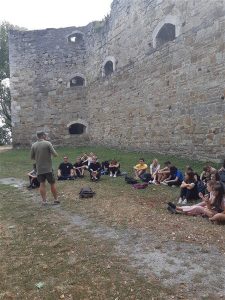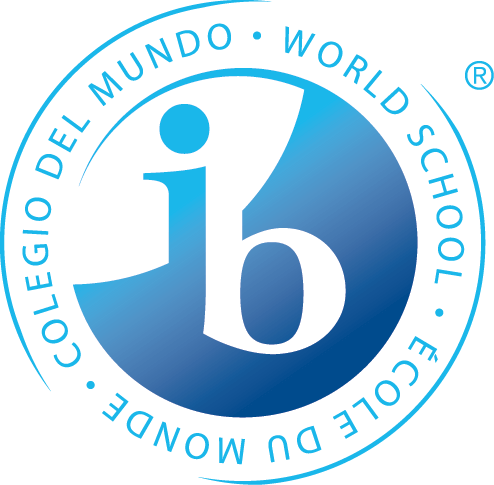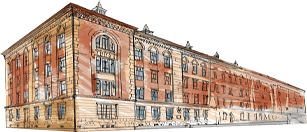A group of young people from High School no.
We visited Żółkiew, Lwów, Olesko, Podhorce, Poczajów, Krzemieniec, Zbaraż, Trembowla, Chocim, and Okopy św. Trinity, Kamieniec Podolski, Złoczów.
The trip to Ukraine took place from 5 to 9 September 2019. 44 students from the second and third grades of our high school and four tutors participated in it.
The gathering of participants took place in Krakow at Wawrzyńca Street. After crossing the border in Korczowa, the participants went towards Żółkiew, where they admired the Roman Catholic collegiate church of St. Wawrzyńca, directly related to the Grand Hetman of the Crown Stanisław Żółkiewski and indirectly with King Jan III Sobieski and his father Jakub. Other places visited were the castle from the turn of the 16th and 17th centuries, the synagogue and the Dominican church. The group went from Żółkiew to Lviv to visit the Łyczakowski Cemetery and the Eaglets’ Cemetery. Tour participants stopped at the graves of distinguished Poles – for example A. Grottger, M. Konopnicka, G. Zapolska, K. J. Ordon, S. Banach. Visiting the necropolises, students gave the Redoubts of Ordon A. Mickiewicz, Rota of M. Konopnicka, Orlątko by A. Oppman, laid flowers and lit candles in reflection. They spent the first night at the Sonata Hotel in Lviv.
The second day was spent under the care of a Polish-born guide who started showing her city from the High Castle. In Lviv, apart from the most important monuments (the Wallachian church, the Armenian cathedral, the Market Square, the Boim chapel, the Jesuit church, the Hetman’s Embankments, the Bernardine church), students could see the little-known monument of Nikifor, a monument dedicated to T. Shevchenko, they also had the opportunity to lay flowers at the monument of the patron saint Adam Mickiewicz VI High School. The walk around the most beautiful part of the city was graced with sightseeing and the presence at the rehearsal at the Lviv National Academic Opera and Ballet Theater. Salomea Kruszelnicka. An important place for Polish history is the Cathedral of the Assumption of the Blessed Virgin Mary, where Jan Kazimierz made his famous vows during the Swedish invasion of 1656. The day spent in Lviv was an excellent history lesson.
On September 7, after waking up, toilets, breakfast and checking out, the group went to Olesko to visit the castle associated with the Sobieski and Rzewuski families. The castle’s collection includes valuable furniture, icons, sculptures and paintings. The next object on the route was the palace in Podhorce built for Hetman S. Koniecpolski, distinguished by a beautiful, extensive surroundings. The castle in Khotyn is completely different in character, it is a defensive structure situated on the high bank of the Dniester. The undoubted advantage was that the students learned about various palace assumptions and architectural solutions. The next object on the route was the Pochayiv Lavra, during which the participants of the trip learned about the Orthodox religion. The stay in the monastery, situated on a hill overlooking the town of Pochayiv, was an opportunity to get to know the richness of eastern sacred architecture. The arrival to Krzemieniec contributed to the broadening of literary knowledge (visiting the Slovak Museum, a walk to the Krzemieniec Secondary School), religious and artistic (parish church, Jesuit church – now an Orthodox church) and historical (castle ruins, Bona mountain). The group spent the next night at a hotel in Krzemieniec.
On the fourth day (Sunday), interested persons had the opportunity to participate in the mass. in the church of st. Stanisław Biskupa and Martyr, then the visitors went to Zbaraż. The fortress is connected with Polish history and literature. Her defense was described by Henryk Sienkiewicz. During the bus ride, students had the opportunity to watch the film adaptation of Fire and Sword. With a view to further sightseeing (Kamieniec Podolski), Mr. Wołodyjowski was also displayed. From Zbaraż, the group went to the site of two important battles in 1621 and 1673 to the castle in Khotyn. A touching episode of the trip was the meeting with the 93-year-old Polish woman. The next stage was related to the Okopy św. Trinity. During the tour, the pilot, Dr. Piotr Rabiej, talked about the times of the Bar Confederation and scenes from Z. Krasiński’s Nie-Boska Komedia. The last night of the trip was spent in Kamieniec Podolski, at the Kleopatra hotel.
In the morning, students saw the Cathedral of the Holy Apostles Peter and Paul with a characteristic minaret, monument to M. J. Wołodyjowski, city fortifications, and then go to the castle in Kamieniec Podolski. The last monument known in Ukraine were the fortifications of the castle in Złoczów. During the trip, the students filled in carefully prepared worksheets. The winners were awarded with souvenirs from the places they visited. After a long journey, crossing the border in Medyka, the trip ended in Krakow at ul. Wawrzyniec, next to the building of High School No. 6.
The main goal of the trip was to get to know the cultural heritage of the Eastern Borderlands. It has been possible to emphasize that the meaning of Kresy lies in the diversity and multiculturalism resulting from the borderland. Students had the opportunity to reflect on the issue of intercultural dialogue, building interpersonal and international relations, and avoiding xenophobic, intolerant, nationalist and chauvinistic attitudes. The sense of healthy national pride was also emphasized, which can be built through learning about the achievements of great ancestors.
The route includes objects related to Polish history (Żółkiew, Lwów, Olesko, Krzemieniec, Zbaraż, Chocim, Okopy Świętej Trójcy, Kamieniec Podolski). Seeing the architectural and urban complexes of old cities and fortresses broadened knowledge of the history of art and made it possible to notice the need to renovate monuments. The landscape values of the places encountered along the route were also important.
Teresa Lityńska-Konieczny
Izabela Klec
Agata Jaszczur
Marcin Mikrut






